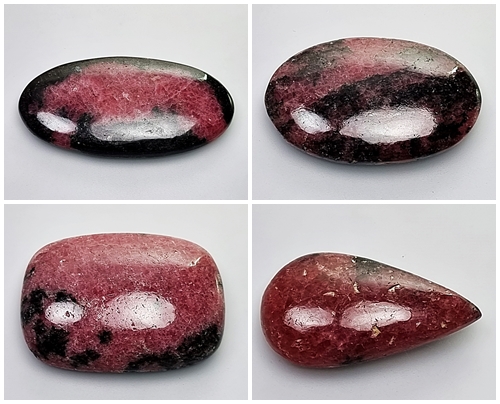Rhodonite: Gemstone Information
Rhodonite is a strikingly beautiful mineral known for its unique pink to rose-red coloration, often accented with black manganese oxide veining. This mineral belongs to the silicate class and is part of the pyroxenoid group. Rhodonite derives its name from the Greek word “rhodon,” which means rose, owing to its characteristic pinkish hues. While primarily valued as a gemstone and ornamental material, Rhodonite also holds significance in various healing and metaphysical practices due to its purported properties and benefits.
Physical Properties:
Rhodonite typically exhibits a pink to rose-red color, often with black veins or patches of manganese oxide. It has a vitreous to pearly luster and a Mohs hardness of around 5.5 to 6.5, making it suitable for jewelry and lapidary purposes. Rhodonite is commonly found in metamorphic rocks, particularly associated with manganese-rich deposits.
Healing and Metaphysical Properties:
In metaphysical and healing traditions, Rhodonite is believed to possess a range of beneficial properties, both spiritually and physically. Some of these properties include:
Emotional Healing: Rhodonite is often associated with emotional healing and balance. It is believed to help release emotional wounds, traumas, and resentments, promoting forgiveness, compassion, and self-love. It encourages emotional stability and inner peace, making it useful for those dealing with stress, anxiety, or relationship issues.
Heart Chakra Activation: Rhodonite is said to resonate strongly with the heart chakra, facilitating the opening and activation of this energy center. By clearing blockages and promoting harmony within the heart chakra, Rhodonite can enhance feelings of love, empathy, and kindness towards oneself and others.
Self-Expression and Creativity: Some practitioners believe that Rhodonite stimulates creativity and encourages self-expression. It is thought to inspire confidence, courage, and passion, empowering individuals to pursue their artistic endeavors and express their true selves authentically.
Physical Healing: In addition to its emotional and spiritual properties, Rhodonite is believed to have physical healing benefits. It is often used to alleviate symptoms associated with inflammation, allergies, and respiratory issues. Some people also use Rhodonite to support the healing of wounds, cuts, and scars.
Grounding and Protection: Rhodonite is thought to have grounding properties, helping individuals stay rooted and connected to the earth’s energies. It is believed to provide a sense of stability and protection, shielding against negativity and psychic attacks.
Balance and Harmony: Overall, Rhodonite is associated with promoting balance and harmony in various aspects of life, including relationships, emotions, and spiritual growth. It encourages alignment with one’s true purpose and fosters a sense of inner peace and fulfillment.
How to Use Rhodonite:
There are several ways to incorporate Rhodonite into your daily life to benefit from its properties:
Jewelry Rhodonite is commonly used in jewelry, such as rings, pendants, and bracelets, allowing for easy wearing and constant energetic support throughout the day.
Meditation: Holding or placing Rhodonite stones during meditation can help amplify its healing energies and facilitate emotional release, inner healing, and spiritual growth.
Placement: Placing Rhodonite crystals in key areas of your home or workspace can promote a harmonious environment and support emotional well-being.
Body Layouts: Some practitioners use Rhodonite in crystal healing layouts, placing stones on specific areas of the body to address physical ailments or emotional imbalances.
Elixirs and Essences: Infusing water with Rhodonite or using Rhodonite essence can provide a gentle yet powerful way to experience its healing properties internally.
Cautions and Considerations:
While Rhodonite is generally considered safe for most people to use, it’s essential to exercise caution, especially if you have known allergies or sensitivities to minerals. Additionally, it’s crucial to remember that Rhodonite and other gemstones are not substitutes for professional medical treatment. Always consult with a qualified healthcare provider for any medical concerns or conditions.
In conclusion, Rhodonite is a captivating mineral that offers a unique blend of beauty and healing properties. Whether used for emotional healing, spiritual growth, or physical well-being, Rhodonite has been cherished for centuries for its ability to promote balance, harmony, and inner peace. Incorporating Rhodonite into your life can be a transformative experience, supporting you on your journey towards holistic health and well-being.





